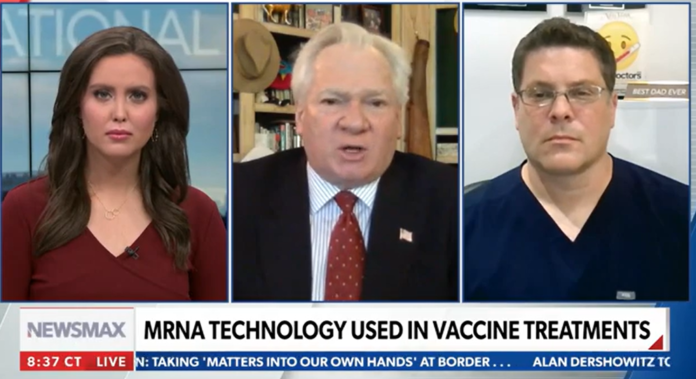David Dodd discussing COVID-19 Vaccines and ‘Emergency Use’ Authorization
EMERGENCY USE AUTHORIZATION EXPLAINED
FDA is globally respected for its scientific standards of vaccine safety, effectiveness and quality. The agency provides scientific and regulatory advice to vaccine developers and undertakes a rigorous evaluation of the scientific information through all phases of clinical trials, which continues after a vaccine has been approved by FDA or authorized for emergency use.
FDA recognizes the gravity of the current public health emergency and the importance of facilitating availability, as soon as possible, of vaccines to prevent COVID-19 – vaccines that the public will trust and have confidence in receiving.
What is an Emergency Use Authorization (EUA)?
An Emergency Use Authorization (EUA) is a mechanism to facilitate the availability and use of medical countermeasures, including vaccines, during public health emergencies, such as the current COVID-19 pandemic. Under an EUA, FDA may allow the use of unapproved medical products, or unapproved uses of approved medical products in an emergency to diagnose, treat, or prevent serious or life-threatening diseases or conditions when certain statutory criteria have been met, including that there are no adequate, approved, and available alternatives. Taking into consideration input from the FDA, manufacturers decide whether and when to submit an EUA request to FDA.
Once submitted, FDA will evaluate an EUA request and determine whether the relevant statutory criteria are met, taking into account the totality of the scientific evidence about the vaccine that is available to FDA.
Are the COVID-19 vaccines rigorously tested?
Yes. Clinical trials are evaluating investigational COVID-19 vaccines in tens of thousands of study participants to generate the scientific data and other information needed by FDA to determine safety and effectiveness. These clinical trials are being conducted according to the rigorous standards set forth by the FDA.
Initially, in phase 1, the vaccine is given to a small number of generally healthy people to assess its safety at increasing doses and to gain early information about how well the vaccine works to induce an immune response in people. In the absence of safety concerns from phase 1 studies, phase 2 studies include more people, where various dosages are tested on hundreds of people with typically varying health statuses and from different demographic groups, in randomized-controlled studies. These studies provide additional safety information on common short-term side effects and risks, examine the relationship between the dose administered and the immune response, and may provide initial information regarding the effectiveness of the vaccine. In phase 3, the vaccine is generally administered to thousands of people in randomized, controlled studies involving broad demographic groups (i.e., the population intended for use of the vaccine) and generates critical information on effectiveness and additional important safety data. This phase provides additional information about the immune response in people who receive the vaccine compared to those who receive a control, such as a placebo.
What safety and effectiveness data are required to be submitted to FDA for an EUA request for a vaccine intended to prevent COVID-19?
COVID-19 vaccines are undergoing a rigorous development process that includes tens of thousands of study participants to generate the needed non-clinical, clinical, and manufacturing data. FDA will undertake a comprehensive evaluation of this information submitted by a vaccine manufacturer.
For an EUA to be issued for a vaccine, for which there is adequate manufacturing information to ensure quality and consistency, FDA must determine that the known and potential benefits outweigh the known and potential risks of the vaccine. An EUA request for a COVID-19 vaccine can be submitted to FDA based on a final analysis of a phase 3 clinical efficacy trial or an interim analysis of such trial, i.e., an analysis performed before the planned end of the trial once the data have met the pre-specified success criteria for the study’s primary efficacy endpoint.
From a safety perspective, FDA expects an EUA submission will include all safety data accumulated from phase 1 and 2 studies conducted with the vaccine, with an expectation that phase 3 data will include a median follow-up of at least 2-months (meaning that at least half of vaccine recipients in phase 3 clinical trials have at least 2 months of follow-up) after completion of the full vaccination regimen. In addition, FDA expects that an EUA request will include a phase 3 safety database of well over 3,000 vaccine recipients, representing a high proportion of participants enrolled in the phase 3 study, who have been followed for serious adverse events and adverse events of special interest for at least one month after completion of the full vaccination regimen.
Part of FDA’s evaluation of an EUA request for a COVID-19 vaccine includes evaluation of the chemistry, manufacturing, and controls information for the vaccine. Sufficient data should be submitted to ensure the quality and consistency of the vaccine product. FDA will use all available tools and information, including records reviews, site visits, and previous compliance history, to assess compliance with current good manufacturing practices.
What is the process that manufacturers are following to potentially make a COVID-19 vaccine available by EUA?
- Vaccine manufacturers are undertaking a development process that includes tens of thousands of study participants to generate non-clinical, clinical, and manufacturing information needed by FDA for the agency to determine whether the known and potential benefits outweigh the known and potential risks of a vaccine for the prevention of COVID-19.
- When the phase 3 portion of the human clinical trial reaches a predetermined point that informs how well a vaccine prevents COVID-19, as discussed and agreed to in advance with FDA, an independent group (called a data safety monitoring board) will review the data and inform the manufacturer of the results. Based on the data and the interpretation of the data by this group, manufacturers decide whether and when to submit an EUA request to FDA, taking into consideration input from FDA.
- After FDA receives an EUA request, our career scientists and physicians will evaluate all of the information included in the manufacturer’s submission.
- While FDA’s evaluation is ongoing, we will also schedule a public meeting of our Vaccines and Related Biological Products Advisory Committee, which is made up of external scientific and public health experts from throughout the country. During the meeting, these experts, who are carefully screened for any potential conflicts of interest, will discuss the safety and effectiveness data so that the public and scientific community will have a clear understanding of the data and information that FDA is evaluating to make a decision whether to authorize a COVID-19 vaccine for emergency use.
- Following the advisory committee meeting, FDA’s career professional staff will consider the input of the advisory committee members and continue their evaluation of the submission to determine whether the available safety and effectiveness and manufacturing data support an emergency use authorization of the specific COVID-19 vaccine in the United States.
Who are the FDA career professionals evaluating EUAs for vaccines?
The FDA staff are career scientists and physicians who have globally recognized expertise in the complexity of vaccine development and in evaluating the safety and effectiveness of all vaccines intended to prevent infectious diseases. These FDA professionals are committed to decision-making based on scientifically driven evaluation of data. FDA staff are like your family – they are fathers, mothers, daughters, sons, sisters, brothers and more. They and their families are also directly impacted by the work that they do, and are exactly who you want making these important public health decisions for the United States.
What are the plans for continued monitoring of COVID-19 vaccines authorized by FDA for emergency use?
FDA expects vaccine manufacturers to include in their EUA requests a plan for active follow-up for safety, including deaths, hospitalizations, and other serious or clinically significant adverse events, among individuals who receive the vaccine under an EUA, to inform ongoing benefit-risk determinations to support continuation of the EUA.
FDA also expects manufacturers who receive an EUA to continue their clinical trials to obtain additional safety and effectiveness information and pursue licensure (approval).
Post-authorization vaccine safety monitoring is a federal government responsibility shared primarily by FDA and the U.S. Centers for Disease Control and Prevention (CDC), along with other agencies involved in healthcare delivery. Post-authorization safety monitoring during the COVID-19 pandemic vaccination program will aim to continuously monitor the safety of COVID-19 vaccines to rapidly detect safety problems if they exist. There will be multiple, complementary systems in place with validated analytic methods that can rapidly detect signals for possible vaccine safety problems. The U.S. government has a well-established post-authorization/post-approval vaccine safety monitoring infrastructure that will be scaled up to meet the needs of a large-scale COVID-19 vaccination program. The U.S. government – in partnership with health systems, academic centers, and private sector partners – will use multiple existing vaccine safety monitoring systems to monitor COVID-19 vaccines in the post-authorization/approval period. Some of these systems are the Vaccine Adverse Event Reporting System (VAERS), the Vaccine Safety Datalink (VSD), the Biologics Effectiveness and Safety (BEST) Initiative, and Medicare claims data.
How will vaccine recipients be informed about the benefits and risks of any vaccine that receives an EUA?
FDA must ensure that recipients of the vaccine under an EUA are informed, to the extent practicable given the applicable circumstances, that FDA has authorized the emergency use of the vaccine, of the known and potential benefits and risks, the extent to which such benefits and risks are unknown, that they have the option to accept or refuse the vaccine, and of any available alternatives to the product. Typically, this information is communicated in a patient “fact sheet.” The FDA posts these fact sheets on our website.
How is it that COVID-19 vaccines have been developed so quickly?
In public health emergencies, such as a pandemic, the development process may be atypical. For example, as demonstrated by the response to the COVID-19 pandemic, the U.S. government has coalesced government agencies, international counterparts, academia, nonprofit organizations and pharmaceutical companies to develop a coordinated strategy for prioritizing and speeding development of the most promising vaccines. In addition, the federal government has made investments in the necessary manufacturing capacity at its own risk, giving companies confidence that they can invest aggressively in development and allowing faster distribution of an eventual vaccine. However, efforts to speed vaccine development to address the ongoing COVID-19 pandemic have not sacrificed scientific standards, integrity of the vaccine review process, or safety.
Recognizing the urgent need for safe and effective vaccines, FDA is utilizing its various authorities and expertise to facilitate the expeditious development and availability of vaccines that have met the agency’s rigorous and science-based standards for quality, safety, and effectiveness. Early in a public health crisis, FDA provides clear communication to the pharmaceutical industry pertaining to the scientific data and information needed to ensure development of vaccines and works quickly to provide advice on their proposed development plans and assessment of the data that are generated.












